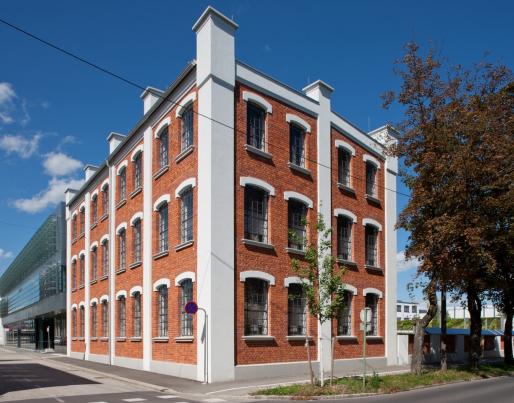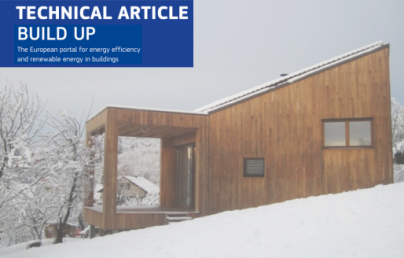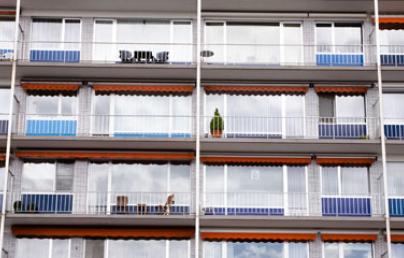From restorative to regenerative sustainability: State of Art and visions for Regenerative Heritage

From restorative to regenerative sustainability: State of Art and visions for Regenerative Heritage
By Egla Luca, Ivan Sulc and Edeltraud Haselsteiner
Within the COST initiative RESTORE -- Rethinking Sustainability TOwards a Regenerative Economy -- since 2017 a network of researchers and experts have been actively addressing the question of what would a paradigm shift in sustainability in the built environment sector look like. A new paradigm calls for a more comprehensive and holistic approach to sustainability, one that focuses less on energy, but rather on actively contributing to the regeneration and improvement of people, society and planet health.
In March 2018, the first results from the project were published in the format of a booklet that gathers all the work produced by the Work Group 1 working in setting the bases of Restorative Sustainability.[1]
Among those results, the work done in the definition, State of the Art and vision for the Regenerative Heritage are key to set a base of discussion around the renovation of existing buildings. As Martin Brown states in his work FutuRestorative: Working Towards a New Sustainability (2016), Restorative Sustainability pursues to restore the capability of social and ecological systems. Thereby Regenerative Heritage can be recovered by increasing the accessibility, its flexibility and the hybridization of functions that can be developed within it.
Living heritage buildings are sharing memories of place from the past and providing us with lessons for the future. Preservation, Restoration, Reconstruction, Reuse and Revitalisation are vital approaches to ensuring our living heritage maintains its cultural richness whilst ensuring an ecologically sound and socially just future.
Heritage represents the history, traditions, environment and historic buildings of a country or area, seen as something to be passed on in good condition to future generations (Bateman et al., 2005). The term heritage is usually associated with unique natural features and areas, as well as buildings of significant historical and/or architectural value. However, in the recent period even industrial buildings, often associated with workers’ settlements, have been largely observed as heritage. Hence, the process of selection of historical elements that will be represented as heritage is always related to construction, reconstruction and deconstruction of memory and identity (McDowell, 2008).
The theoretical approach to sustainability and cultural heritage starts from the concept of REUSE. First, not every corner can be an urbanized land, because it goes against modern theories of sustainable urbanization, which underline the fact that by 2050, 80% of the world population will be concentrated in cities. This will be followed by overcrowding and shortage of fertile surfaces. So, reuse of buildings in this regard is meaningful.
REVITALIZATION is another valuable theoretical concept. Certainly, the establishment of some new functions associated and activities within the former heritage site would give another dimension to the area, the dimension of public realm, space and social life.
The subordinate approach, based on restorative or regenerative sustainability (Brown 2016), is Regenerative Heritage. The idea is to go beyond existing standards of reducing negative impacts, and to move from standardized solutions to locally, culturally and environmentally integrated built environments. Thereby Restorative Sustainability pursues to restore the capability of social and ecological systems, while Regenerative Sustainability is seen as a future level where social and ecological systems are enabled to continuously regenerate and evolve.
Three approaches are proposed for urban regeneration of heritage sites:
a) Redevelopment degradation intervention
Redevelopment, known as demolition of existing buildings and re-use of cleared land for the implementation of new projects. This approach is applicable to cases in which objects are in seriously deteriorated condition and not worth preserving and could not provide satisfactory living conditions.
b) Rehabilitation
Rehabilitation, preservation or conservation as it is often called, can be defined as the opposite of redevelopment. It is based on maintaining, repairing and restoring the natural environment and man-made one in existing neighbourhoods. Rehabilitation is applicable in areas where buildings are generally in good structural condition but are deteriorating due to neglect maintenance. Rehabilitation fits well with the emerging Circular Economy.
c) Integration
The third approach to urban regeneration, known as integration, this concept sees rehabilitation and redevelopment as complementary forces and combines the best aspects of both approaches (Zhu Zixuan 1981)
Our Vision for Sustainable Development: ‘The recognition, mainstreaming and effective contribution of cultural heritage as a driver and enabler of sustainable development in the process of implementing the United Nations Agenda 2030 and Sustainable Development Goals.” (ICOMOS Action Plan 2017, p. 4)
Currently, the State of the art regarding existing building stock is considered to be “non-sustainable” in terms of use, materials, function, accessibility and regeneration.
To draw some conclusions, some industrial buildings were used to assess the key topics related to Regenerative Heritage: Place, Energy and Carbon, Water and Resources, Wellbeing, Equity and Education.
Place – low accessibility to the zone (i.e. suburban or restricted zones of industrial settlements), pollution of the area, visual degradation of the landscape, occupation of central areas that could benefit from other functions, urban growth of the city where the heritage is located, problems of ownership, lower prices of real estates in the surrounding areas, insecurity. Heritage is often considered as a barrier to (more rapid) urban development. People attribute memories related to a heritage area with no real architectonic or historical value and resist to any transformation of the area. Our Building Heritage should be a visual, social, cultural, economical (i.e. tourism) catalyst for the place and the community.
Energy and carbon – there is no relationship between renewable energy and historic buildings, lack of aesthetic adaptation, lack of insulation and ventilation, LCA impact in terms of construction and transportation, carbon impact, contradictory between energy efficiency measures and protection of monuments (i.e. aesthetic changes due to insulation), historic building concepts specifically addressing industrial use (i.e. no heating or only residual heat of the industrial production) can only be adapted to other uses (for example living) with great effort.
There is a growing awareness that new constructions, generating more energy than they use, (for example as Living Building Challenge projects do) can assist in providing energy to heritage buildings that are unable to generate renewable energy themselves.
Water and resources – heritage is not considered as an economic resource by itself. There is the opportunity however to view heritage buildings and their components through the lens of the circular economy. As an alternative to demolition, building components can be transplanted into other or new constructions and so preserve memories and cultural from the original building.
The Ellen MacArthur Foundation sees cities where “Components of buildings will be maintained and renewed when needed, while buildings will be used where possible to generate, rather than consume, power and food by facilitating closed loops of water, nutrients, materials, and energy, to mimic natural cycles” (Ellen MacArthur Foundation 2017, Cities in the Circular Economy).
Wellbeing – new forms of gathering, indoor air quality, participation, rehabilitation in terms of structure and energy, sustainability of the city and the buildings (use and value), memory.
Equity – heritage buildings have been generally designed and constructed without todays view on equity, human access for all and building user health & wellness consideration. It is essential that equity is seen as a core imperative in heritage building reuse and revitalization.
Education – continuing knowledge, memory awareness and recognition (people and government), heritage is a vital element of sustainability, not to be excluded from ambitious restorative approaches.
The actions that should be taken after analysing the state-of-the-art focus on Conservation of the memory in terms of people, place and buildings. Recognition from both public and private sector to conserve memory in continual use is a key element in the regeneration process.
Through re-vitalizing heritage buildings, we can ensure buildings and cities make a positive contribution to their community, place and the Sustainable Development Goals, not just making buildings ‘less bad’.
The heritage per se is excluded from energy standards, but these buildings should be included in the energy efficiency regulation.
They are becoming threats for new buildings because in some cases they become a barrier to development because of the ownership issues, hence the government should facilitate and regulate all the ownership issues.
Finally, in order to overcome the state of the art, an assessment to increase the consciousness on heritage and to valorise it through restorative regeneration is proposed. The assessment should pass through the following elements:
- The surrounding environment and environmental conditions (place).
- The vicinity to the urbanized area (the accessibility of the zone).
- The existing conditions of the former building.
- The current function of the former zone.
In terms of bringing back the memory of heritage one of the most important things to be done is to increase the accessibility in terms of information and physical connection. The major challenge that rose from our gap analysis was the management of change and the integration process. People many times resist to changes, so in order to overcome this obstacle we should give flexible function, but we should keep elements of the history.
It is needed to increase the awareness of the young generation through educational programs (university courses, high schools) with multidisciplinary approach (history, architecture, civil engineering, geography, sociology). Afterwards, it is key the creation of a general platform with all the information about heritage, recognition and promotion. The final outcome of such impute should be the shift from conservation point of view to regeneration and to put into function after the consult with professionals and locals.
References
- Bateman, H., Harris, E., McAdam, K. (eds.), 2005: Dictionary of Leisure, Travel and Tourism (Third Edition), A & C Publishing, London.
- Brown, M., 2016. FutuREstorative: Working Towards a New Sustainability. RIBA Publishing.
- Convery, I., Corsane, G., Davis, P., 2012: Introduction: Making sense of place, in: Making Sense of Place: Multidisciplinary Perspectives (eds. Convery, I., Corsane, G., Davis, P.), The Boydell Press, Woodbridge, 1-8.
- ICOMOS Action Plan: ‘Cultural Heritage and Localizing the SDGs’, Draft Version 2 (April 5, 2017), to be reviewed by ICOMOS Scientific and National Committees (http://www.icomos.org/images/DOCUMENTS/UN_SDG/SDGs_Meeting_Istanbul_201702/ICOMOS_Draft_Action_Plan_Localizing_the_SDGs_20170406.pdf)
- Ellen MacArthur Foundation, 2017: Cities in the Circular Economy https://www.ellenmacarthurfoundation.org/assets/downloads/publications/Cities-in-the-CE_An-Initial-Exploration.pdf
- Encyclopaedia Britannica, 2018: Soil. Pedology, https://www.britannica.com/science/soil (Accessed on 7th January 2018).
- Knox, P., Marston, S., 2017: Human Geography: Places and Regions in the Global Context (4th Edition), Cram101 Textbook Reviews.
- Luca Egla, 2017 “The reuse of Albanian Industrial Archeology as an approach to sustainability and conservation - Research on the new evidences of expression of the former industrial buildings with the implication of 3R; Retrofit, Re-Use, Revitalize.” Ferrara Italy
- McDowell, S., 2008: Heritage, memory and identity, in: The Ashgate Research Companion to Heritage and Identity (eds. Graham, B., Howard, P.), Ashgate, 37-54.
- Ng., V., 2013: Toward a holistic understanding of sense of place: A phenomenological reading of Chew Jetty, Penang, International Journal of Humanities and Social Science 3 (20), 75-83.
- World Atlas, 2017: The Five Themes In Geography, http://www.worldatlas.com/the-five-themes-in-geography.html (24 September 2017).
- Zhu Zixuan, 1981 : Habitat International. Volume 15, Issue 3, 1991, Pages 133–138. “Preservation and redevelopment in Beijing” Zhu Zixuan “Revitalizing cities” H. Briavel Holcomb, Robert A. Beauregard, Association of American Geographers, 1981
[1] Brown, M., Haselsteiner, E., Apro, D., Kopeva, D., Luca, E., Pulkkinen, K., Vula Rizvanolli, B., (Eds.), (2018). Sustainability, Restorative to Regenerative. COST Action CA16114 RESTORE, Working Group One Report: Restorative Sustainability. Download: http://www.eurestore.eu/wp-content/uploads/2018/04/Sustainability-Restorative-to-Regenerative.pdf


